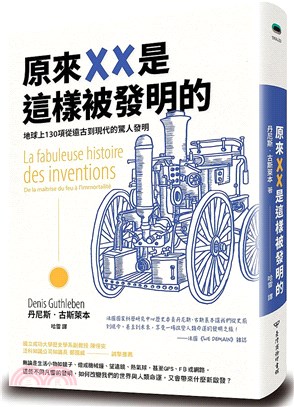人民幣定價:90 元
定價
:NT$ 540 元優惠價
:87 折 470 元
絕版無法訂購
商品簡介
名人/編輯推薦
目次
書摘/試閱
相關商品
商品簡介
《藥物化學(英中雙語注解版)(第2版)》是藥物化學專業唯一一本英中雙語教材。以英文編寫,加以中文注釋。全書分為17章,前6章為總論部分,主要闡述藥物研發的基本理論和基本方法,內容包括新藥研究中先導化合物的發現和結構優化、藥物與受體相互作用、酶及其抑制劑的基礎理論和應用、藥物代謝的基本概念、前藥的設計及計算機輔助藥物設計的基礎知識。第7~17章為各論,按目前新藥研究的重點領域分類,主要內容包括神經系統藥物、鎮痛及麻醉藥、代謝綜合征治療藥、胃腸道系統藥物、心血管系統藥物、抗腫瘤、抗病毒、抗真菌、抗感染及免疫抗炎藥,重點講解各類藥物治療現狀、作用機制、結構與活性關系,代表性藥物的合成路線設計、臨床應用及藥物代謝的相關知識。
名人/編輯推薦
《藥物化學(英中雙語注解版)(第2版)》對第一版進行了修訂,增減了相關內容,形式更緊湊,內容更精練。介紹藥物研發的基本理論與方法,以及目前新藥研究重點領域的藥物治療現狀、藥物的作用機理、構效關系等,并以代表性藥物作為案例進行講解。適合藥物化學專業的師生和專業技術人員使用。
目次
第二版前言
第一版前言
1Drug Discovery,Design and Development
1.1Drug Discovery
1.1.1ADrug Discovery without a Lead
1.1.2Lead Discovery
1.2Lead Modification
1.2.1Identification of the ActivePart:The Pharmacophore
1.2.2Structure Modifications to Increase Potency and the The rapeutic Index
1.3New Drug Development
1.3.1General Process of New Drug Development
1.3.2Preclinical Development and Investigational New Drug Application
1.4Problems
本章重點內容
2Receptors
2. 1 Drug-Receptor Interactions
2. 1.1 Interactions (Forces) Involved in the Drug-Receptor Complex
2.2 Theories for Drug-Receptor Interactions
2. 2. 1 Induced-Fit Theory
2. 2.2 The Two- State (Multistate) Model of Receptor Activation
2.3 Topographical and Stereochemical Considerations
2.3.1 Spatial Arrangement of Atoms
2. 3.2 Drug and Receptor Chirality
2. 3.3 Geometric Isomers (Diastereomers)
2. 3.4 Conformational Isomers
2.3.5 Ring Topology
2.4 Problems
本章重點內容
3Enzymes and Enzyme Inhibition
3.1 Enzymes
3.1.1 Enzymes as Catalysts
3.1.2 Mechanism of Enzyme Catalysis ...
3.1.3 Coenzyme Catalysis
3.2 Enzyme Inhibition
3.2. 1 Enzyme Inhibitors in Medicine
3.2. 2 Design of Enzyme Inhibitors
3.3 Reversible Enzyme Inhibitors
3.3.1 Mechanism of Reversible Inhibition
3.3.2 Selected Examples of Competitive Reversible Inhibitor Drugs
3.3.3 Transition State Analogs
3. 3.4 Slow, Tight- Binding Inhibitors
3.4 Irreversible Enzyme Inhibitors
3.4. 1 Affinity Labeling Agents
3.4. 2 Mechanism-Based Enzyme Inactivators
3.5 Problems
References
本章重點內容
4DrugMetabolism
4. 1 Introduction
4. 2 Phase I Transformations
4. 2. 1 Oxidative Reactions
4. 2. 2 Reductive Reactions
4. 2.3 Carboxylation Reaction
4. 2. 4 Hydrolytic Reactions
4. 3 Phase Ⅱ Transformations: Conjugation Reactions
4. 3.1 Introduction
4. 3.2 Glucuronic Acid Conjugation
4. 3.3 Sulfate Conjugation
4. 3.4 Amino Acid Conjugation
4. 3.5 Glutathione Conjugation
4. 3.6 Acetyl Conjugation
4. 4 Problems
本章重點內容
5Prodrugs and Drug Delivery System
5.1 Introduction
5.1.1 Utility of Prod_rugs
5.1.2 Types of Prodrugs
5.2 Mechanism of Drug Activation
5.2. 1 Carder-Linked Prodrugs
5.2.2 Bioprecursor Prodrugs
5.3 Problems
本章重點內容
6 Computer Aided Drug Design
6. 1 Introduction
6. 1.1 Molecular Mechanics and Empirical Force Field Methods
6. 1.2 Energy Minimization
6. 1.3 Conformational Analysis and Search
6. 2 Structure-Based Drug Design
6. 2. 1 Molecular Graphics-Based Drag Design
6. 2.2 Molecular Docking
6. 2. 3 De Novo Drugs Design
6.3 Ligand Based Drug Design
6.3.1 Quantitative Structure-Activity Relationships
6.3.2 Pharmacophore Modeling
6. 4 Problems
本章重點內容
7 Central Nervous System Drugs
7.1 Schizophrenia
7. 1.1 Introduction
7. 1.2 Stucture-activity Relationship of Tricyclic Anti-psychotics
7.1.3 Typical Drugs
7.1.4 Discovery and Development of New Antipsychotic Drags
7.2 Sedative-hypnotics
7.2. 1 Introduction
7.2. 2 Stucture-activity Relationship of Benzodiazepines
7.2.3 Typical Drugs
7.2.4 New Research Areas
7.3 Alzheimer's Disease
7.3.1 Introduction
7.3.2 Typical Drugs
7.3.3 New Research Areas
7.4 Problems
References
本章重點內容
8 Analgesics and Anesthetics
8. 1 Analgesics
8. 1.1 Introduction
8.1.2 Opioid Receptor
8. 1.3 Endogenous Opioid Peptides
8.1.4 Morphine and Related Opioids
8. 1.5 Synthetic Analgesics
8. 1.6 Unmet Medical Needs
8.1.7 New Research Areas
8.2 Anesthetics
8.2. 1 General Anesthetics
8.2. 2 Local Anesthetics
8.2.3 Unmet Medical Needs
8.3 Problems
本章重點內容
9 Drugs for Metabolic Syndrome Treatment
9. 1 . Obesity
9. 1.1 Current Treatment
9. 1.2 New Research Areas
9.2 Diabetes
9.2. 1 Current Treatment
9. 2.2 New Research Areas
9. 3 Problems
References
本章重點內容
10 Agents for Gastrointestinal Diseases
10. 1 Introduction
10. 1.1 The Function of Gastrointestinal Tract
10. 1.2 Historical Overview
10. 2 Gastric and Mucosal Ulceration
10. 2. 1 Overview
10. 2. 2 H2 Receptor Antagonists
10. 2.3 Proton Pump Inhibitors (PPIs)
10.2.4 New Research Areas
10. 3 Inflammatory Bowel Disease
10. 3 1 Overview
……
11Cardiovascular Agents
12Anticancer Agents
13Antiviral Agents
14Antifungal Agents
15Antibacterials
16Antiparasitic
17Inflammatory Diseases and Nonsteroidal Anti-inflammatory Drugs(NSAIDs)
第一版前言
1Drug Discovery,Design and Development
1.1Drug Discovery
1.1.1ADrug Discovery without a Lead
1.1.2Lead Discovery
1.2Lead Modification
1.2.1Identification of the ActivePart:The Pharmacophore
1.2.2Structure Modifications to Increase Potency and the The rapeutic Index
1.3New Drug Development
1.3.1General Process of New Drug Development
1.3.2Preclinical Development and Investigational New Drug Application
1.4Problems
本章重點內容
2Receptors
2. 1 Drug-Receptor Interactions
2. 1.1 Interactions (Forces) Involved in the Drug-Receptor Complex
2.2 Theories for Drug-Receptor Interactions
2. 2. 1 Induced-Fit Theory
2. 2.2 The Two- State (Multistate) Model of Receptor Activation
2.3 Topographical and Stereochemical Considerations
2.3.1 Spatial Arrangement of Atoms
2. 3.2 Drug and Receptor Chirality
2. 3.3 Geometric Isomers (Diastereomers)
2. 3.4 Conformational Isomers
2.3.5 Ring Topology
2.4 Problems
本章重點內容
3Enzymes and Enzyme Inhibition
3.1 Enzymes
3.1.1 Enzymes as Catalysts
3.1.2 Mechanism of Enzyme Catalysis ...
3.1.3 Coenzyme Catalysis
3.2 Enzyme Inhibition
3.2. 1 Enzyme Inhibitors in Medicine
3.2. 2 Design of Enzyme Inhibitors
3.3 Reversible Enzyme Inhibitors
3.3.1 Mechanism of Reversible Inhibition
3.3.2 Selected Examples of Competitive Reversible Inhibitor Drugs
3.3.3 Transition State Analogs
3. 3.4 Slow, Tight- Binding Inhibitors
3.4 Irreversible Enzyme Inhibitors
3.4. 1 Affinity Labeling Agents
3.4. 2 Mechanism-Based Enzyme Inactivators
3.5 Problems
References
本章重點內容
4DrugMetabolism
4. 1 Introduction
4. 2 Phase I Transformations
4. 2. 1 Oxidative Reactions
4. 2. 2 Reductive Reactions
4. 2.3 Carboxylation Reaction
4. 2. 4 Hydrolytic Reactions
4. 3 Phase Ⅱ Transformations: Conjugation Reactions
4. 3.1 Introduction
4. 3.2 Glucuronic Acid Conjugation
4. 3.3 Sulfate Conjugation
4. 3.4 Amino Acid Conjugation
4. 3.5 Glutathione Conjugation
4. 3.6 Acetyl Conjugation
4. 4 Problems
本章重點內容
5Prodrugs and Drug Delivery System
5.1 Introduction
5.1.1 Utility of Prod_rugs
5.1.2 Types of Prodrugs
5.2 Mechanism of Drug Activation
5.2. 1 Carder-Linked Prodrugs
5.2.2 Bioprecursor Prodrugs
5.3 Problems
本章重點內容
6 Computer Aided Drug Design
6. 1 Introduction
6. 1.1 Molecular Mechanics and Empirical Force Field Methods
6. 1.2 Energy Minimization
6. 1.3 Conformational Analysis and Search
6. 2 Structure-Based Drug Design
6. 2. 1 Molecular Graphics-Based Drag Design
6. 2.2 Molecular Docking
6. 2. 3 De Novo Drugs Design
6.3 Ligand Based Drug Design
6.3.1 Quantitative Structure-Activity Relationships
6.3.2 Pharmacophore Modeling
6. 4 Problems
本章重點內容
7 Central Nervous System Drugs
7.1 Schizophrenia
7. 1.1 Introduction
7. 1.2 Stucture-activity Relationship of Tricyclic Anti-psychotics
7.1.3 Typical Drugs
7.1.4 Discovery and Development of New Antipsychotic Drags
7.2 Sedative-hypnotics
7.2. 1 Introduction
7.2. 2 Stucture-activity Relationship of Benzodiazepines
7.2.3 Typical Drugs
7.2.4 New Research Areas
7.3 Alzheimer's Disease
7.3.1 Introduction
7.3.2 Typical Drugs
7.3.3 New Research Areas
7.4 Problems
References
本章重點內容
8 Analgesics and Anesthetics
8. 1 Analgesics
8. 1.1 Introduction
8.1.2 Opioid Receptor
8. 1.3 Endogenous Opioid Peptides
8.1.4 Morphine and Related Opioids
8. 1.5 Synthetic Analgesics
8. 1.6 Unmet Medical Needs
8.1.7 New Research Areas
8.2 Anesthetics
8.2. 1 General Anesthetics
8.2. 2 Local Anesthetics
8.2.3 Unmet Medical Needs
8.3 Problems
本章重點內容
9 Drugs for Metabolic Syndrome Treatment
9. 1 . Obesity
9. 1.1 Current Treatment
9. 1.2 New Research Areas
9.2 Diabetes
9.2. 1 Current Treatment
9. 2.2 New Research Areas
9. 3 Problems
References
本章重點內容
10 Agents for Gastrointestinal Diseases
10. 1 Introduction
10. 1.1 The Function of Gastrointestinal Tract
10. 1.2 Historical Overview
10. 2 Gastric and Mucosal Ulceration
10. 2. 1 Overview
10. 2. 2 H2 Receptor Antagonists
10. 2.3 Proton Pump Inhibitors (PPIs)
10.2.4 New Research Areas
10. 3 Inflammatory Bowel Disease
10. 3 1 Overview
……
11Cardiovascular Agents
12Anticancer Agents
13Antiviral Agents
14Antifungal Agents
15Antibacterials
16Antiparasitic
17Inflammatory Diseases and Nonsteroidal Anti-inflammatory Drugs(NSAIDs)
書摘/試閱
3. 4 Irreversible Enzyme Inhibitors
A competitive irreversible enzyme inhibitor, also known as an active-site directedirreversible inhibitor or an enzyme inactivator, is a compound whose structure is similar tothat of the substrate or product of the target enzyme and which generally forms a covalentbond to an active site residue. In the case of irreversible inhibition it is not necessary tosustain the inhibitor concentration to retain the enzyme-inhibitor interaction. Because this is anirreversible reaction, once the target enzyme has reacted with the irreversible inhibitor, thecomplex cannot dissociate, and, therefore, the enzyme remains inactive, even in the absenceof additional inhibitor. This effect could translate into the requirement for smaller and fewerdoses of the drug. Even though the target enzyme is destroyed by the irreversible inhibitor, itdoes not mean that only one dose of the drug would be sufficient to destroy the enzymepermanently. Yes, it destroys that copy of the enzyme permanently, but our genes areconstantly encoding more copies of proteins that diminish in concentration. As the enzymeloses activity, additional copies of the enzyme are synthesized, but this process can take hoursor even days. In some cases, however, particularly where genetic translation of the targetenzyme is slow, it may be safer to design reversible inhibitors whose effects can be controlledmore effectively by termination of their administration.
The term irreversible is a loose one; either a very stable covalent bond or a labile bondmay be formed between the drug and the enzyme active site. As pointed out earlier, some tight-binding reversible inhibitors also are functionally irreversible.
主題書展
更多
主題書展
更多書展今日66折
您曾經瀏覽過的商品
購物須知
大陸出版品因裝訂品質及貨運條件與台灣出版品落差甚大,除封面破損、內頁脫落等較嚴重的狀態,其餘商品將正常出貨。
特別提醒:部分書籍附贈之內容(如音頻mp3或影片dvd等)已無實體光碟提供,需以QR CODE 連結至當地網站註冊“並通過驗證程序”,方可下載使用。
無現貨庫存之簡體書,將向海外調貨:
海外有庫存之書籍,等候約45個工作天;
海外無庫存之書籍,平均作業時間約60個工作天,然不保證確定可調到貨,尚請見諒。
為了保護您的權益,「三民網路書店」提供會員七日商品鑑賞期(收到商品為起始日)。
若要辦理退貨,請在商品鑑賞期內寄回,且商品必須是全新狀態與完整包裝(商品、附件、發票、隨貨贈品等)否則恕不接受退貨。
優惠價:87
470
絕版無法訂購
























